I have been sewing garments, toys and home accessories since I was 8 years old, which is—oh dear!—going to be six decades in a couple of months. I began sewing handwovens well before I became a weaver, and there’s a story there, which I’ll tell you later. In the meantime, since I’m about to assert that sewing with handwovens is really no different from sewing with other fabrics, let’s review a few simple principles we need to follow in order to make attractive garments.
1. Suit the fabric to the pattern. Light, drapey cotton or linen twill is not going to work in a tailored suit, no matter how hard you try to force it. You will never be happy wearing a bulky wool plain weave blouse, despite the attractive colors.
2. Suit the pattern to yourself. If you buy tailored clothing and enjoy wearing them, assume anything you’ll make should fit your preferences. Alternatively, if your inner flower child has surfaced, go with the flow(y).
3. Get real about your size. Yes, we all love pretending we’re a size 10, when the measuring tape says we’re a pattern 18. Clothing manufacturers lie. Ever wonder why it’s called “vanity sizing” in the industry? If you want to look like Queen Muffin Top, go ahead and make the pattern 10. If you want to look chic, pay attention to the pattern measurements and choose your actual size pattern. If, like many of us, you’re two different sizes, make sure the top fits well and do what you must to adjust the bottom.
4. Ummmm. About those stripes? Vertical lines are slimming. Horizontal lines are not. However, horizontals can be used, judiciously, to emphasize your assets. Those would be appearing somewhere above your waist, otherwise they will be abbreviated to—well, you know.
5. “Stabilize” does not mean “petrify”. If you have ever tailored a suit, you know that flexibility is always preserved throughout the padding and stitching process. Garments, unlike table runners, need to flex with your body’s movements. If they don’t, it’s a bit like wearing body armor, useful for riding your motorcycle, but not a lot of fun working in your garden, your studio or your day job. For the same reason, while you want to finish your seams in some way to prevent them from raveling, avoid sealing products like Fray Chek which will stiffen the edges, and be judicious with your serger settings to avoid a rigid edge on a flexible twill garment.
How many more rules do you want? There are many more out there roaming among the various sewing columns and blogs, but maybe it’s time to talk about handweaving for garments. First of all, did you notice the first four principles? All of them will dictate how you design the fabric for the garment that you want to weave. If you want to make a coat, you’ll need to think about how outerwear works. It won’t touch your body, it will probably have a separately-constructed lining, and it should be stable enough to hold its shape. Plain weave, a tightly-spaced twill and a number of other weave structures, such as overshot, will do very nicely. Coats have big surfaces, so you can create bold patterns, if you wish. If it’s a plaid, make sure (see 4 above) that it’s balanced or that the dominant color(s) will run vertically. It’s up to you to choose what structure and colors will please you and to create this fabric.
Vests are even easier, and bridge the gap between outerwear and indoor accessories. Since they’ll have smaller pieces and be seen close up, make sure your pattern is in scale. When you want to weave fabric for blouses, skirts or other “indoor” garments, generally speaking, you will think of cotton, silk or linen, and in finer gauges, such as 10/2 or 20/2 cotton, for example. Since they’ll be closer to the body, choosing a twill structure will give you some desirable flexibility.
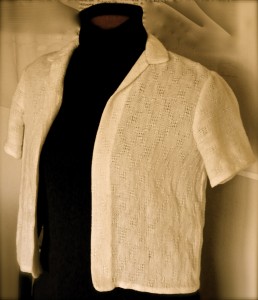
bolero
That’s the easy part. Those of you who sample consistently can jump over the following paragraph and move on to “How to Sew Your Handwoven”. For the rest of us, the problem is that however well we plan, plot and generally have all the answers ready, we wind up with yardage which isn’t quite what we hoped to produce. Bad us—but our numbers are legion.
So your huck lace blouse yardage shrinks to dimensions which won’t cover you decently? Make a bolero jacket.
Your kimono project produces plenty of yardage, but the anticipated draw-in plus shrinking when washed is inadequate and the “kimono” would be enormously wide? Quickly convert your plans to a vest plus a shawl.
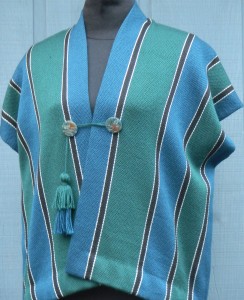
Planned a kimono-got a vest
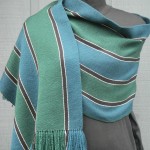
planned as sleeves- became a shawl
The most demanding experience I have had was approximately 25 years ago, when my mother, Lucianne Miller, sent me plenty of yardage, which she had just woven. She thought that the cotton log cabin weave might make a kimono. The yardage was indeed very attractive, and more than enough to make a garment,
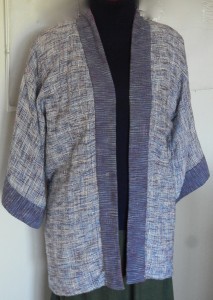
Kimono Style jacket
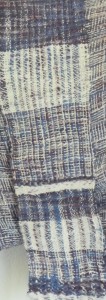
sample strip for trim
but the problem was that there was no way to construct any kind of front or sleeve band from the original fabric, which worked. Because any possible band made from the existing fabric would be in contact with the front, back or sleeves, it would just look messy. At that point the sampling began. Altogether, Mom probably wove at least 20 samples, which she mailed to me in strips as she completed them As you can see, the finished product has served me for a couple of decades, but the original project, which took perhaps a week of her time, was only completed to our satisfaction after an additional week of thinking through what might possibly work and then trying to achieve that effect.
How to Sew Your Handwoven
Did you see the September/October 2011 Handwoven? Follow the sewing principles you already know, and you’ll be all right. Walking through the CNCH 2010 fashion show entries with Darryl Lancaster was very educational, but you probably know most of the approaches that she mentioned. Stabilize, but judiciously. Don’t chop up a medium-dimension plaid in little tiny pieces to make a “jeans jacket”. If you’re stabilizing a mobile weave structure, be judicious and let it move a little (knit, rather than woven interfacing). Serging to stop raveling can be useful, but be careful not to run over edges which don’t need the help, such as selvedges.
Above all, relax. It’s just cloth. If you treat it as you created it, it will do the job you designed it to do.
There are many methods of designing, cutting and sewing your handwoven material. For one more approach, go to the next article.